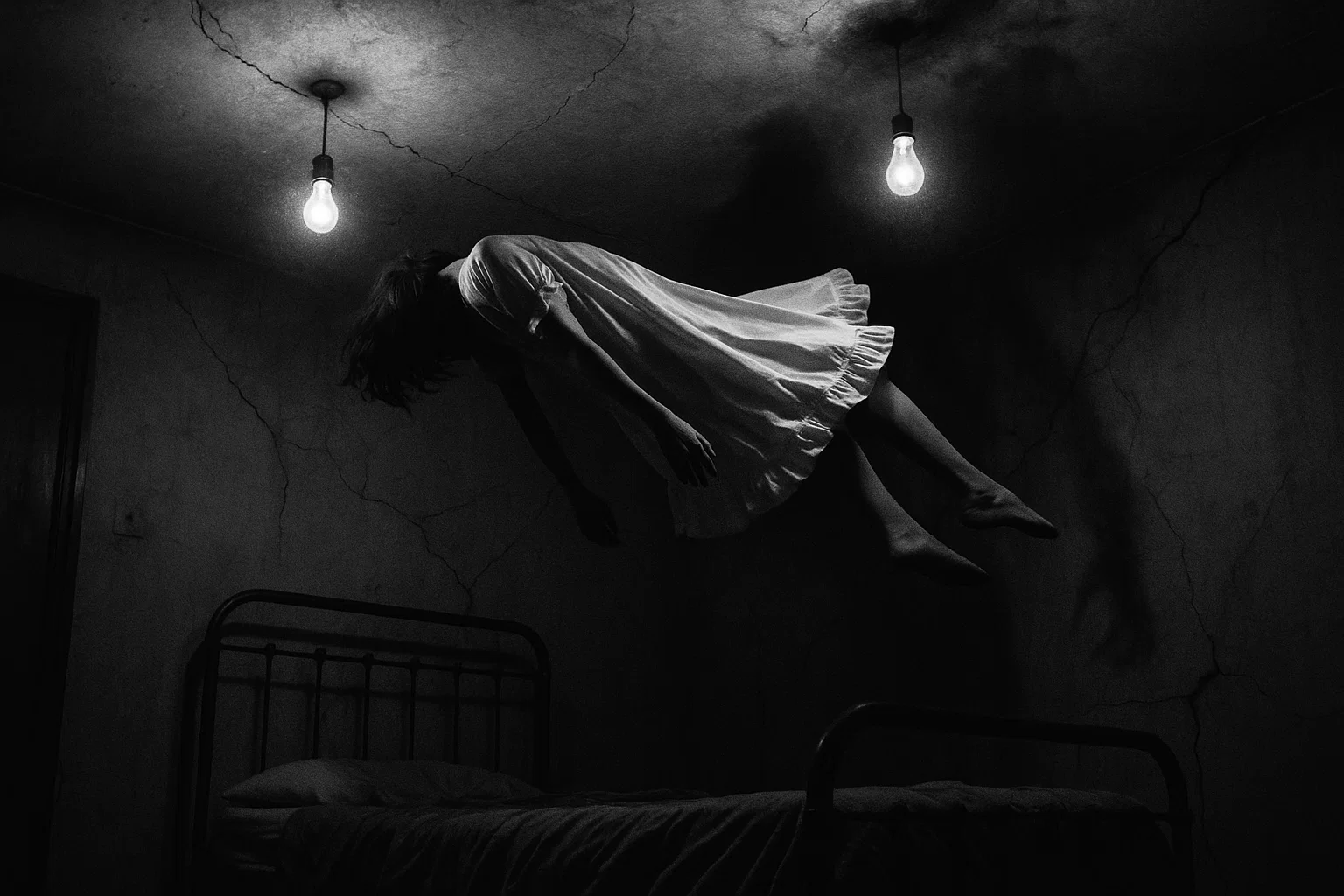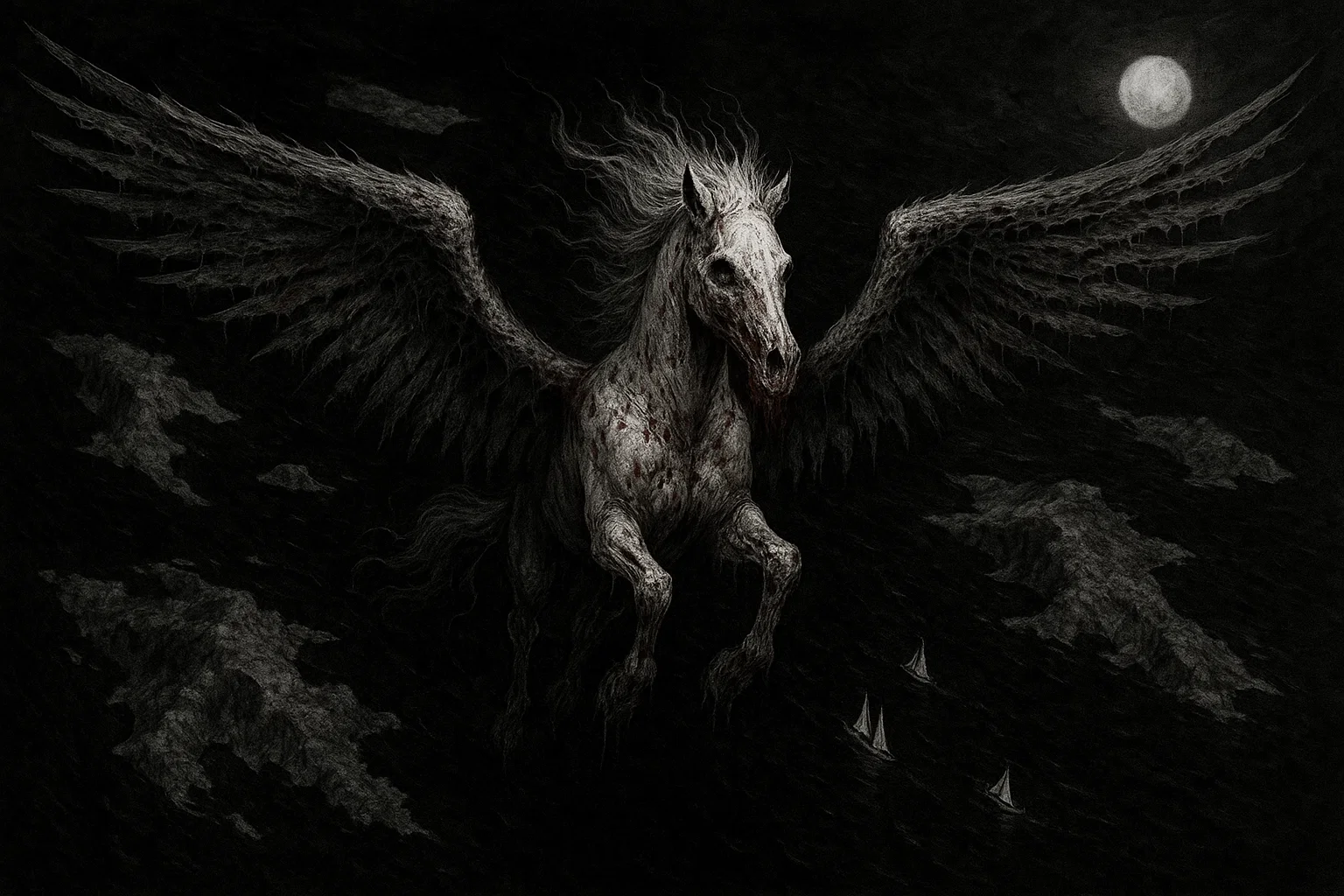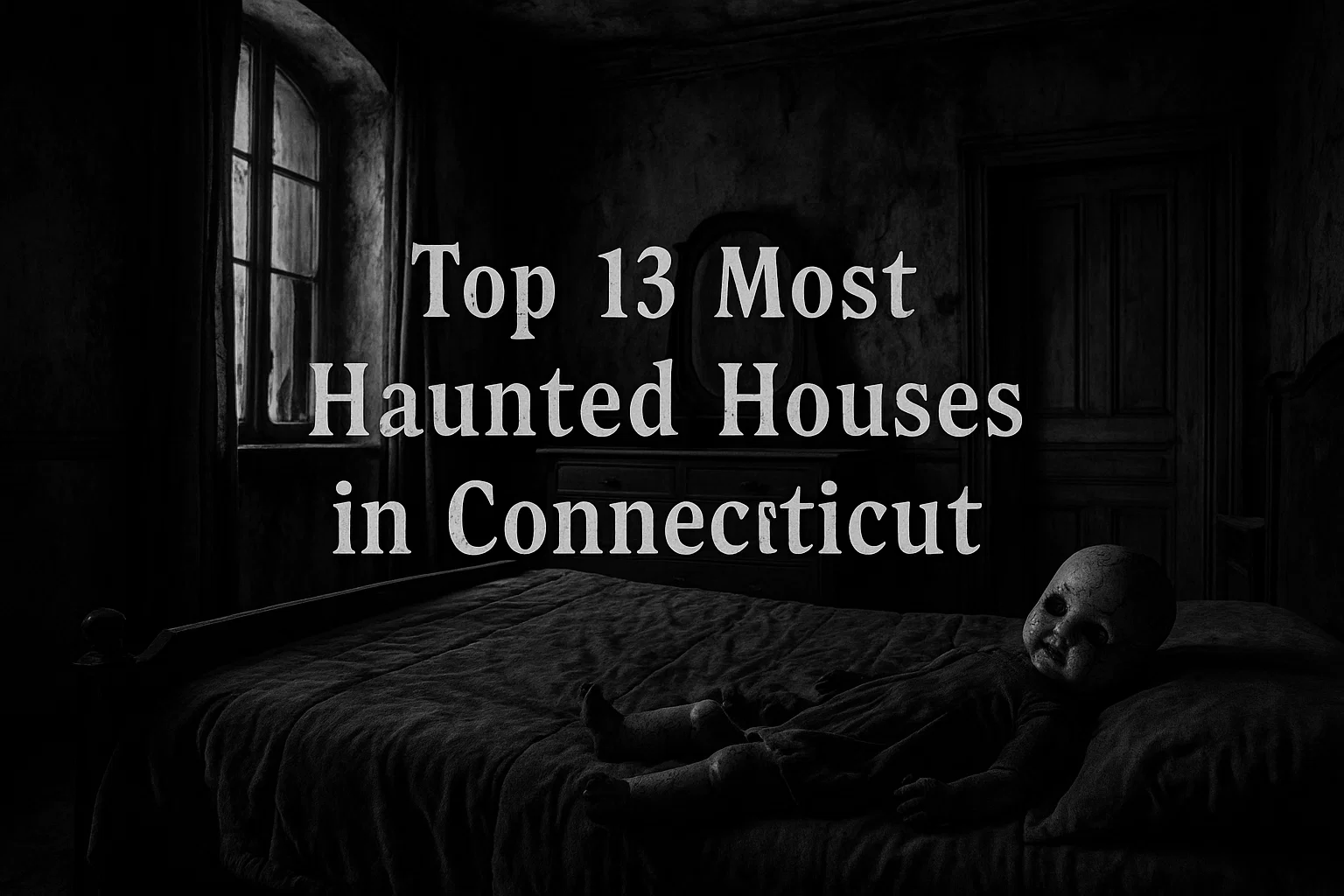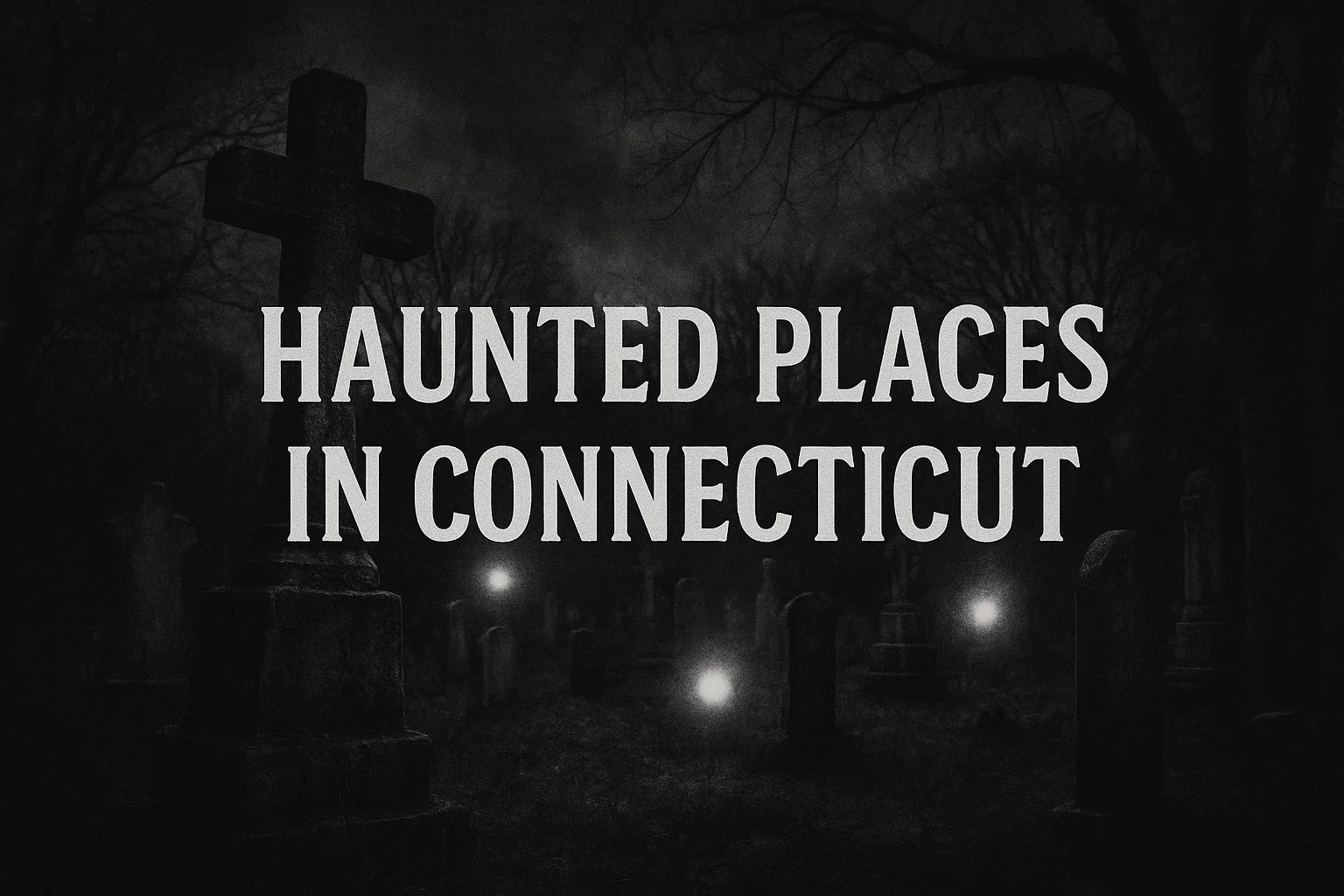The Enfield poltergeist refers to a series of alleged paranormal events that took place at a modest council house in Enfield, North London, from 1977 to 1979.
Centered on the Hodgson family—particularly 11-year-old Janet Hodgson—the disturbances included furniture moving on its own, loud knocking sounds, objects flying through the air, and a gruff voice claiming to be the spirit of a deceased former resident.
These incidents drew widespread media attention, investigators from the Society for Psychical Research, and even American paranormal experts, turning the ordinary suburban home into a focal point for debates on the supernatural.
What made the Enfield haunting stand out was its duration—over 18 months—and the volume of witnesses, including police officers, journalists, and neighbors, who reported inexplicable phenomena. Yet, skepticism persisted; some incidents were later attributed to pranks by the children involved.
Despite this, the case remains one of the most documented poltergeist encounters in modern history, inspiring books, films, and ongoing discussions.
Summary
Key Takeaways
| Attribute | Details |
|---|---|
| Name | Enfield Poltergeist; alternative names include Enfield Haunting and The Hodgson Poltergeist Case |
| Location | 284 Green Street, Brimsdown, Enfield, London, England, United Kingdom |
| History | No major tragic events directly tied to the property; the alleged spirit, “Bill Wilkins,” reportedly died of a brain hemorrhage in the house in 1933, but records confirm he passed away in a hospital—though his son later lived there briefly |
| Type of Haunting | Poltergeist; some elements of Intelligent haunting due to responsive communications and targeted disturbances |
| Entities | “Bill Wilkins”, a gruff-voiced elderly man claiming to be a former resident; other voices identified as “Fred,” “The Jester,” and historical figures like “King Richard I” |
| Manifestations | Loud knocking and banging; furniture levitating or sliding; toys and household objects hurled across rooms; cold spots and unexplained breezes; scratches and bruises on residents; levitation of Janet Hodgson; guttural voices speaking through Janet; pools of water appearing spontaneously; electrical malfunctions |
| First Reported Sighting | August 31, 1977—a chest of drawers moved in Janet and Margaret’s bedroom, followed by knocking sounds |
| Recent Activity | No new reports since 1979; in 2023–2024, renewed interest via documentaries and plays, but no fresh incidents at the property—current residents report nothing unusual |
| Open to the Public? | No, the house remains a private residence, though exterior photos and tours of Enfield are available for paranormal enthusiasts |
What Is the Enfield Poltergeist?
The infamous Enfield poltergeist happened at 284 Green Street, a modest semi-detached council house in the Brimsdown area of Enfield, North London—a working-class suburb far from the grandeur of traditional ghost tales.
Single mother Peggy Hodgson lived there with her four children: daughters Margaret, 13, and Janet, 11, and sons Johnny, 10, and Billy, 7.
What began as minor creaks and thuds escalated into chaotic disturbances that disrupted daily life for over a year. Investigators documented more than 2,000 incidents, from chairs gliding across floors to a child’s body seemingly hurled into the air.
At its core, the haunting embodied classic poltergeist traits: noisy, physical chaos often linked to adolescents, especially girls in puberty.
Janet became the epicenter; she levitated above her bed, suffered unexplained scratches, and channeled a raspy voice purporting to be Bill Wilkins, a man who had lived—and allegedly died—in the house decades earlier.
Witnesses described an oppressive atmosphere: sudden temperature drops, barking dogs in empty rooms, and furniture flipping without touch. Yet, the property itself held no dark legacy—no murders or fires marred its history, only the quiet passage of ordinary families since its construction in the 1920s.
The case gripped 1970s Britain amid economic strife and cultural obsession with the occult, fueled by films like The Exorcist. Media swarmed the site, amplifying claims while skeptics pointed to the girls’ occasional giggles amid the terror.
How the Enfield Poltergeist Started?
The Enfield poltergeist was a strange case. Unlike other hauntings (that were typically linked to tragic events that happened at the location), the house on Green Street, Brimsdown, was no hotspot for tragedy. No infamous crimes, mysterious suicides, bizarre accidents, or calamitous fires scarred its records.
Yet, the paranormal manifestations began in August 1977, when Peggy Hodgson, recently separated and scraping by on a seamstress’s wage, noticed odd vibrations in her home. The property, rented from the local council since 1967, had housed unremarkable tenants before—families raising children, enduring the grind of postwar austerity without spectral fanfare.
So what could trigger the manifestations? Investigators later pointed out an interesting detail: the timing of the events coincided with Janet starting her puberty, which is often linked to poltergeist activity.
You May Also Like: 15 True Ghost Stories You Shouldn’t Read Alone After Midnight
Enfield Poltergeist Ghost Sightings
| Date | Witness(es) | Description | Evidence | Outcome |
|---|---|---|---|---|
| August 31, 1977 | Peggy Hodgson, Janet Hodgson, Margaret Hodgson | Voice of “Bill Wilkins” speaks through Janet for the first time; describes death details. | Family testimony; no photos. | Police called next day; initial skepticism. |
| September 1, 1977 | WPC Carolyn Heeps, Hodgson family | Janet levitated 4–5 feet above the floor; captured in a mid-air photo. | Police statement; verbal report. | Heeps convinced of genuineness; case logged. |
| October 1977 | Maurice Grosse, Peggy Hodgson | The chest of drawers moved forward twice in the girls’ bedroom, making knocking sounds from the walls. | Audio recording of knocks; Grosse’s notes. | Grosse stayed overnight; activity increased. |
| December 15, 1977 | Guy Lyon Playfair, Maurice Grosse, Janet Hodgson | The armchair slid 3–4 feet across the kitchen floor unaided; it wobbled before moving. | Graham Morris’s photograph; witnesses’ affidavits. | Warrens depart after a short visit; no exorcism. |
| January 6, 1978 | Multiple journalists, investigators | Warren’s report; family accounts. | Over 30 minutes of tape-recorded dialogue. | Verified partial details via records; media storm begins. |
| August 1978 | Ed and Lorraine Warren, Hodgson family | Chairs rotate in circle; cold spots noted. | Janet was hospitalized briefly; it was a peak activity day. | Chairs rotate in a circle; cold spots noted. |
| April 1979 | SPR Committee (Mary Rose Barrington et al.) | Final knocks and object throws; property inspected. | Committee transcripts; no new photos. | Activity ceases; investigation concludes. |
The Enfield Poltergeist
August 31–September 1, 1977: The Bedroom Drawer
On August 31, things took a strange turn in the upstairs bedroom shared by sisters Janet and Margaret. A heavy wooden dresser seemed to move on its own, sliding forward as if pushed by invisible hands.
When their mom, Peggy, noticed, she pushed it back into place, but it slid forward again—twice more. The girls screamed, and their brothers, Johnny and Billy, froze in shock.
“It felt like something pushed it,” Janet later recalled, her voice shaky during interviews.
There was no clear reason for it—no loose floorboards or earthquakes to explain what was happening.
As the nights went on, the strange happenings got even creepier. Odd knocking sounds echoed from the walls—four knocks at a time, like a code that no one could figure out. Furniture didn’t just shift; it moved in bizarre ways.
A big chair that no child could move spun around completely in front of witnesses. Toys like Lego bricks and a clown doll flew through the air, hitting people and breaking things.
The following morning, September 1, the situation got even scarier. With the children at home from school, a heavy armchair by the fireplace in the kitchen started to shake.
WPC Carolyn Heeps, who came in response to Peggy’s urgent phone call, arrived expecting a normal family dispute. Instead, she witnessed the armchair—a sturdy piece of furniture with solid legs—wobbling side-to-side before sliding about three to four feet toward the wall.
“It moved… slowly at first, then faster,” Heeps noted in her report, which provided rare official validation of the events. “There were no strings or hidden devices; the room was completely empty.”
December 15, 1977: Janet’s Levitation
In December, a bitter cold swept through the town of Enfield, matching the strange happenings at 284 Green Street. By mid-month, investigators Maurice Grosse and Guy Lyon Playfair had recorded countless mysterious knocks in the house, almost as if someone was trying to communicate through a kind of ghostly code.
But on December 15, things escalated dramatically.
Janet seemed unusually quiet and went to bed early. Suddenly, blood-curdling screams echoed throughout the home. Playfair rushed upstairs to find something unbelievable: Janet was lying on her bed, which was suddenly rising 4 to 5 inches off the ground and then slamming down with such force that it shook the walls.
Playfair noted in his journal that it looked as if the bed was being lifted by invisible wires. Neighbors, including Vic Nottingham, watched in shock as the bed bucked wildly, throwing pillows and blankets everywhere.
Then the situation took an even stranger turn. Graham Morris, a photographer for the Daily Mirror, was there to capture the event on camera. He snapped a photo just as Janet seemed to “fly” across the room, soaring 4 feet before crashing into the wall.
The picture showed her mid-air, eyes wide and limbs flailing, defying explanation. Morris later dismissed accusations that it was a hoax, pointing out that Janet’s flight path didn’t look normal; it was too horizontal and too far for a simple jump. She ended up with bruises and scratches, as if something had clawed at her.
Downstairs, things were chaotic too: a sideboard had been knocked over, and toys were raining down from above. The temperature dropped dramatically, making breath visible in the icy air, while unseen dogs seemed to bark frantically from nowhere.
That evening also marked a significant moment in Janet’s life, as it was the first time she had her period. Some suggested that this might have triggered the strange events as a form of unexplained energy release. Grosse recorded frantic knocks that lined up perfectly with the date, while Playfair sensed a powerful force at work.
The media quickly caught on, with The Sun boldly declaring “Poltergeist Terror!” But alongside the excitement came skepticism.
Later videos showed Janet bending spoons, leading some to speculate she was just playing tricks. Still, over a dozen witnesses that night firmly believed something supernatural was happening, citing the eerie force they observed.
This night marked the peak of the haunting, firmly placing Enfield in the spotlight of national interest.
You May Also Like: The Complete List of All Haunted Places in Arkansas
January 6, 1978: The Voice of Bill Wilkins
The winter of 1978 was especially cold, but the Hodgson family’s home was even colder—filled with a strange tension. On January 6, during a gathering that felt like a séance, something unusual happened.
The poltergeist moved beyond just making noises and began to speak. Janet seemed to go into a trance while lying on her bed. Her body twisted in bizarre ways, and suddenly a deep voice broke through: “Just before I died, I went blind… then I had a hemorrhage!”
The voice allegedly belonged to Bill Wilkins, an elderly man who lived in the house many decades earlier.
The recorder belonging to the researchers, Grosse and Playfair, picked up 30 minutes of Bill’s gravelly voice, filled with strange words and old memories. He talked about how much he hated being dead, and even coughed as if he had a lung condition.
Surrounding Janet, the adults listened in disbelief as Bill answered their questions accurately. When they asked how old he was when he died, he said, “Seventy-two.” He mentioned his family, too—a wife and son, who had visited the house after he passed away.
Neighbors were shocked; some remembered an old man who fit Bill’s description and was known to be rather grumpy. As the session went on, furniture began to shake. Janet seemed to transform; her usual voice vanished, replaced by Bill’s for several hours.
When she finally came back to her senses, she had no memory of what had happened, only a sore throat.
Following this incredible event, investigators quickly checked records. They found proof that Bill Wilkins had indeed lived at a nearby address until 1933 and had died from a brain hemorrhage, although it happened in a hospital, not at home.
His son had visited the house several times after Bill’s death, leading to some confusion. Some skeptics tried to say that Janet was simply mimicking or faking the voice, but experts who analyzed the recordings found that there were no signs of her using ventriloquism; her voice and throat had changed in odd ways.
Critics noted that Janet had been on a TV show that featured stories about ghosts, suggesting she might have been inspired to create a story of her own. But the details Bill shared were specific and accurate.
This event showed that the haunting at the Hodgson home was more than just random disturbances; it suggested that there was a story behind it, a connection to the past that made the experience feel real and frightening for the girls involved.
What happened at Enfield elevated the idea of intelligent hauntings—where spirits seem to communicate—transforming a simple case of poltergeist activity into something far more profound.
August 1978: The Rotating Chairs
In the scorching summer, the Enfield poltergeist activity was making waves, attracting the attention of Ed and Lorraine Warren (famous for their work in the Amityville case).
On August 31, exactly one year after the first reported manifestation, they arrived to investigate the situation alongside Peggy and her daughter, Janet.
Ed urged the spirit to show itself. To everyone’s shock, two empty chairs started to spin slowly, then gained speed like a wild ride. Lorraine, taking notes, described it as “a carousel from Hell” as a sudden chill blew through the room, sending papers flying. Janet tensed up as faint knocks responded to Ed reading from the Bible.
The Warrens believed that there was a darker presence at play and suggested performing an exorcism. Lorraine even claimed to have a vision of someone named Wilkins, hinting at more sinister forces.
Witnesses (including journalist Douglas Bence) felt an electrifying energy in the air that made their hair stand on end. While there were no paranormal levitations this time, Janet showed new scratches on her arms during the session, appearing as if they were being written onto her skin. Ed’s recording device faced technical problems too, with strange whispers replacing the regular sounds during playback.
However, their visit was short-lived; tensions grew when local researcher Playfair rejected their offer to write a book about the case, straining their relationship.
Critics later argued that the Warrens focused too much on possession stories rather than the actual poltergeist activity.
You May Also Like: 11 Most Haunted Houses in Alabama That Locals Swear Are Truly Possessed
Theories
The Enfield poltergeist has sparked endless debate, blending eyewitness accounts with scientific scrutiny. Explanations range from supernatural intrusion to psychological strain.
However, no single theory satisfies all the evidence—over 2,000 logged incidents, tapes, and photos.
Genuine Poltergeist Activity Linked to Recurrent Spontaneous Psychokinesis (RSPK)
Supporters of the Enfield Poltergeist case, like Maurice Grosse and Guy Lyon Playfair, believe that the strange happenings were caused by a phenomenon called RSPK—which stands for “recurrent spontaneous psychokinesis.”
In simpler terms, they think it was a release of psychic energy, likely triggered by the stress of a young girl named Janet, who was just 11 years old and dealing with her parents’ separation during a tough time in her life. This internal struggle seemed to turn into real-life disturbances.
Similar incidents have happened before (such as in Rosenheim in 1967 and Thornton Heath in 1972), where young people caused chaos in their homes without any clear explanation.
Witnesses, including police officers and reporters, observed these bizarre events firsthand, ruling out the possibility of tricks or hoaxes. Grosse even recorded sounds that appeared to respond to questions asked, making it hard to believe this was just a case of ventriloquism.
Playfair’s book, This House Is Haunted, lists over 30 independent accounts that further support these claims, including instances where stones seemed to fly through the air.
Some believe that the voice of a man named Wilkins, who died in the house, is an “imprint,” or a lasting emotional trace from his life, which, combined with Janet’s energy, might have caused these phenomena.
On the other hand, critics argue that such psychic occurrences are extremely rare. Still, they note that the Enfield case lasted for an amazing 18 months and involved about 2,000 individual events, showing a pattern of increasing intensity before finally lessening as Janet grew older.
If these events were real, they suggest that humans might possess untapped powers, with Janet’s traumatic experiences acting as a trigger, transforming her sorrow into the strange activities that terrified her family.
Partial Hoax Perpetrated by the Hodgson Children
Some voices (like magician Milbourne Christopher) believe that much of what happened during the Enfield haunting was just kids playing pranks for attention.
They think that sisters Janet and Margaret were faking certain spooky events because their home life was chaotic. There are some admitted tricks (like using hidden tape recorders and bending spoons) that make their claims seem less credible.
As for the famous levitation photo, it likely just shows Janet jumping in the air, which is easy to explain since she was a kid with a lot of energy. The eerie voices that were reported? A ventriloquist, Ray Alan, was able to imitate one of them with ease, saying that Janet learned how to mimic that voice from similar stories on television.
The situation was also influenced by the tough economic climate of 1977, which left their mother, Peggy, feeling overwhelmed. The media attention turned the scared children into performers, which might have skewed what actually went on.
Anita Gregory from the Society for Psychical Research even mentioned that some of the incidents seemed staged for journalists and that the sisters were caught giggling during moments that were supposed to be frightening.
Chris French, writing for Time Out, pointed out several warning signs that contributed to doubt about the haunting, like inconsistencies in witness accounts and the fact that hoaxes were common following the popularity of the movie “The Exorcist.”
However, not everything can be explained away as a hoax. For example, a police officer witnessed a chair sliding across the floor when no one was around, and there were strange knocks that happened before their story got publicized.
It seems that while some parts were exaggerated for attention, there were real moments of stress that could have caused other odd occurrences, perhaps from the house settling.
You May Also Like: Consolation Church Cemetery Haunting: A Terrifying Ghost Story
Psychological Manifestation of Familial Stress and Trauma
Psychologist Chris French and others believe that the Enfield poltergeist case was actually a result of group anxiety rather than supernatural forces.
They suggest that the family’s struggles—including Peggy’s divorce, financial difficulties, and the stress of raising four kids in a small space—created a lot of tension. Janet, one of the children, was going through puberty, which intensified the situation, leading to what they describe as a “shared delusion” among family members.
The strange noises reported (like banging sounds) could have been the result of sleep deprivation, making people hear things that weren’t there. Similarly, furniture moving might have simply been people subconsciously moving it without realizing it.
Although doctors at Maudsley Hospital found no signs of mental health issues with Janet, it seems she was still dealing with a lot of emotional turmoil. Her experiences of feeling “possessed” could reflect her struggles and feelings of anger that she couldn’t express.
However, some physical evidence (like bent fireplace bolts and unexplained bruises) raises questions about purely psychological explanations.
Intelligent Haunting by Residual Spirit Entities
Guy Lyon Playfair and Ed Warren explored the idea that the haunting in Enfield was caused by the ghost of a man named Wilkins, who seemed to be stuck in the house due to unresolved issues from his past.
They believed that his ghost was connected to his son’s experience living in that home. Strange knocks and voices suggested that this wasn’t just random activity, but rather a spirit trying to communicate. Particularly chilling was the detail about “Bill,” which indicated he might have been aware of his death.
Other spirits, like “Fred,” seemed to add to the eerie atmosphere, hinting that more than one spirit was present, possibly drawn in by the strong energy of the young people in the house. Evidence they gathered included recordings showing responses to questions, such as a spirit saying “hate the dark” when the lights were out.
Witnesses like Grosse saw ghosts and experienced the classic signs of hauntings, reminiscent of well-known sites like Borley Rectory. While some believed there could be a darker force at play, Playfair thought the haunting was more about loneliness and not malicious in nature.
However, after certain blessings were performed in 1979, the activity seemed to quiet down.
Environmental and Technological Factors Amplifying Misinterpretation
Some less exciting but more likely explanations for strange happenings include everyday issues like vibrations from nearby trains or faulty wiring, which sparked initial fears that grew due to people’s expectations.
The noise from Enfield’s industrial surroundings could be easily mistaken for mysterious knocks, and water leaking from pipes could create unsettling sounds. Old technology from the 1970s could lead to equipment problems too, with batteries dying in the cold and tape recordings getting distorted.
While there were no scientific records to prove unusual activities, the closeness of the tube station can help explain the strange thuds people heard.
As for stories of levitation, these could simply be tricks of the light in dim conditions or injuries caused by people panicking. Journalist Rosalind Morris noted unusual noises coming from vents, which could add to the confusion.
Psychologist French talks about how people tend to see things that confirm what they already believe. Witnesses often perceived occurrences based on what they expected to see.
You May Also Like: The 12 Creepiest Halloween Horror Stories Ever Told
Cultural Influence from Contemporary Media and Suggestion
In the 1970s, there was a big interest in the occult, with movies like The Exorcist (1973) and Amityville Horror (1975) capturing people’s imaginations. This wave of fascination inspired many, including viewers of shows like Blue Peter, to mimic the spooky themes either intentionally or without even realizing it.
Supporters of these claims noted that some of the strange events resembled scenes from films—like objects levitating or unusual voices, similar to what’s seen in movies about possession. One critic even described the events as a kind of performance.
Enfield Poltergeist vs Other Haunted Locations
| Haunted Location | Type | Key Manifestations | Duration | Location | Notable Investigators/Witnesses |
|---|---|---|---|---|---|
| Amityville Horror House | Demonic/Poltergeist | Swarms of flies; slime oozing from walls; levitating family members; demonic pig sightings | 28 days (1975) | Amityville, New York, USA | Ed and Lorraine Warren; George and Kathy Lutz |
| Borley Rectory | Intelligent Haunting/Apparitions | Nun’s ghost gliding; bells ringing; writing on walls; spontaneous fires | 1929–1939 (main activity) | Borley, Essex, England | Harry Price; Rev. Harry Bull |
| Battersea Poltergeist | Poltergeist | Apportations (objects appearing); automatic writing; knocks following a teen girl | 1956–1970 (14 years) | Battersea, London, England | Shirley Hitchings; Society for Psychical Research |
| Rosenheim Poltergeist | Poltergeist/RSPK | Lights flickering; phones exploding; files flying in an office | 1967 (several months) | Rosenheim, Bavaria, Germany | Jesuit priests, William S. Bowdern |
| Thornton Heath Poltergeist | Poltergeist | Stones thrown; furniture smashing; scratches on residents | 1972–1976 (4 years) | Thornton Heath, London, England | Local vicar; family witnesses |
| Epworth Rectory | Poltergeist/Apparitions | Groans; footsteps; bed-shaking; whispers of “family prayers” | 1716–1717 | Epworth, Lincolnshire, England | Wesley family; Methodist founders |
| St. Louis Exorcism House | Demonic/Possession | Child’s violent contortions; guttural voices; aversion to holy objects | 1949 | Bel-Nor, Missouri, USA | Joe Gibson’s family; vicars |
| Smurl Haunting | Demonic/Poltergeist | Rape by entity; odors; levitating beds; wall knocks | 1974–1987 | West Pittston, Pennsylvania, USA | Ed and Lorraine Warren; Jack and Janet Smurl |
| Bell Witch Cabin | Intelligent/Demonic | Slaps and pinches; prophecies; animal mutilations; voice mimicking family | 1817–1821 | Adams, Tennessee, USA | John Bell family; Andrew Jackson |
| Black Monk of Pontefract | Poltergeist/Apparitions | Clothing raining from the sky; bed flips; voices through children | 1966–1974 (intermittent) | Pontefract, West Yorkshire, England | Hans Bender, parapsychologist |
| Matthew Manning Case | RSPK/Thoughtform | Fires starting; objects materializing; writings on walls by “dead” artists | 1960s–1970s (youth) | Cambridge, England | Matthew Manning; medical tests |
| Carroll County Poltergeist | Poltergeist | Joe Gibson’s family, vicars | 1930 | Carroll County, Virginia, USA | Local ministers; family of 13 |
| King’s Lynn Poltergeist | Poltergeist | Plates smashing; apparitions; knocks responding to commands | 1997–1998 | King’s Lynn, Norfolk, England | Modern SPR; homeowner |
| San Pedro House Haunting | Intelligent/Apparitions | EVPs; shadow figures; child cries; objects moved | 1980s–present | Tucson, Arizona, USA | TAPS team; park rangers |
| Myrtles Plantation | Ghosts (General)/Apparitions | Mirror reflections of slaves; piano playing; choking sensations | 1800s–present | St. Francisville, Louisiana, USA | Historic tours; visitors |
Is Enfield Poltergeist Haunting Real?
The Enfield poltergeist story remains a key topic in the world of paranormal investigation—full of intriguing details yet still open to interpretation.
With thousands of witnesses, many recorded experiences, and physical evidence like bent objects, it suggests something unusual might be happening.
However, there were also admitted hoaxes and psychological factors at play, which remind us to be careful in what we believe; the cultural chaos of the 1970s might have turned ordinary troubles into legends. The situation is neither completely proven nor entirely dismissed, reflecting our ongoing struggle with the unknown—showing both our fears and our potential.
You May Also Like: 10 Scary Campfire Stories That’ll Keep Everyone Awake All Night
Frequently Asked Questions
What is the Enfield Poltergeist?
The Enfield Poltergeist refers to a series of strange and seemingly supernatural events that took place at a house at 284 Green Street in Enfield, North London, between 1977 and 1979. These disturbances primarily affected the Hodgson family, especially 11-year-old Janet Hodgson. People reported things like furniture moving on its own, loud knocking sounds, and objects flying across the rooms.
Was the Enfield poltergeist case genuine?
Opinions about whether the Enfield case was real are quite mixed. More than 30 witnesses, including police officers, said they saw things like a chair sliding by itself. However, some skeptics point out that the children involved admitted to faking some of the events and that the media of the time may have exaggerated the situation. Investigators recorded over 2,000 incidents and captured sounds like knocking in response to questions. Yet, psychological experts think that family stress might have contributed to the reported experiences.
Did Ed and Lorraine Warren investigate the Enfield poltergeist, or are they just actors in a movie (Conjuring)?
Ed and Lorraine Warren, known paranormal investigators, visited the Enfield house in 1978. They noted some minor phenomena, like chairs moving. Still, their involvement wasn’t as prominent as that of the main investigators, Grosse and Playfair. In the movie “The Conjuring 2,” the Warrens’ role is exaggerated and dramatized, including elements like exorcisms and a demon named Valak, which wasn’t part of the real events.
As an atheist, how do you explain the Enfield Poltergeist, given its significance?
Skeptics often explain the Enfield occurrences as a combination of childish pranks, normal settling noises from an old house, and the fascination with the supernatural that was popular in the 1970s, especially after the release of “The Exorcist.” Janet Hodgson even admitted to faking some of the famous levitation photographs. Additionally, the strange voices captured were similar to ventriloquism techniques that kids could replicate.
If the Enfield poltergeist was a hoax, how do we explain the ripping out of the heavy fireplace, which happened quickly and with great force (bending the metal)?
One of the most striking events was when a gas fireplace was reportedly ripped from the wall, with its pipe bent at a sharp angle, all happening overnight without a clear cause. Skeptics suggest that it could have been due to loose fittings or even possible tampering by adults while the children were unsupervised, especially since no photos of the event exist.
What is the identity of the Enfield Poltergeist?
The primary spirit linked to these disturbances was said to be “Bill Wilkins,” an older man who claimed to have lived in the house and died there in 1933. He reportedly spoke through Janet in a raspy voice that matched historical records of his death. Other voices, including those of a soldier named “Fred” and a playful spirit called “The Jester,” suggested there might be more than one spirit involved, or perhaps these were aspects of the children’s psyche.
What’s the most reliable and documented case of paranormal activity in human history?
The Enfield case stands out for its extensive documentation—over 2,000 recorded incidents, eyewitness accounts from journalists and religious figures, and audio evidence analyzed by experts. This level of detail is greater than many other well-known stories, like the Amityville case. The research conducted at the time set a high standard for investigations into paranormal claims, blending a critical approach with the strange occurrences reported, and these efforts have influenced how we study the unexplained in our lives today.







